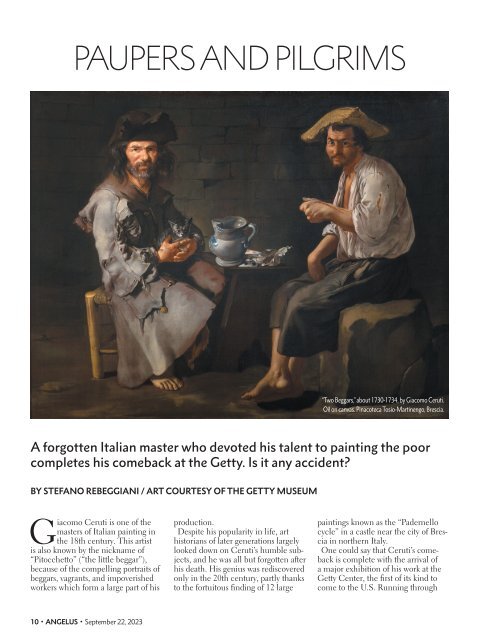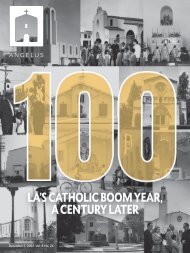You also want an ePaper? Increase the reach of your titles
YUMPU automatically turns print PDFs into web optimized ePapers that Google loves.
PAUPERS AND PILGRIMS<br />
A forgotten Italian master who devoted his talent to painting the poor<br />
completes his comeback at the Getty. Is it any accident?<br />
BY STEFANO REBEGGIANI / ART COURTESY OF THE GETTY MUSEUM<br />
“Two Beggars,” about 1730-1734, by Giacomo Ceruti.<br />
Oil on canvas. Pinacoteca Tosio-Martinengo, Brescia.<br />
Oct. 29, “Giacomo Ceruti, A Compassionate<br />
Eye” brings together 17 of<br />
Ceruti’s finest works.<br />
There are more than a few aspects<br />
that make this one of the Getty’s most<br />
important exhibits in recent years.<br />
The quality of Ceruti’s painting is extraordinary,<br />
and his realistic style and<br />
sympathetic attitude make his works<br />
easy to appreciate even for those with<br />
no particular knowledge or interest in<br />
painting. And it’s hard to believe that<br />
the exhibit’s destination is by chance,<br />
in a city where the plight of the homeless<br />
and those living on the margins of<br />
society has never been more visible.<br />
According to art historian Tom Nichols<br />
(“The Art of Poverty,” Manchester<br />
University Press, $114.64), there are<br />
two major trends in the way European<br />
artists depicted the poor from the 16th<br />
century onward. An ‘ironic’ approach<br />
was predominant in <strong>No</strong>rthern Europe,<br />
where the destitute were<br />
stereotypically depicted<br />
as lazy, deceitful, and<br />
morally debased. In the<br />
Catholic world, however,<br />
an idealized view<br />
prevailed which looked<br />
at the impoverished<br />
individual as “another<br />
Christ” (“alter Christus”).<br />
The work of Caravaggio<br />
marked a major turning<br />
point in this tradition.<br />
He was the first to devote<br />
“Women Working on Pillow<br />
Lace (The Sewing School),”<br />
about 1720-1725, by Giacomo<br />
Ceruti. Private Collection.<br />
Jesus, Mary, and the saints. There<br />
was an outcry when his “Madonna di<br />
Loreto” was uncovered and viewers<br />
noticed the dirty feet and scrappy hat<br />
of the pilgrims depicted at the Virgin<br />
Mary’s feet.<br />
historical characters.<br />
The first painting in the exhibition<br />
depicts an elderly beggar, sitting alone<br />
against a blurred background. He<br />
looks at the viewer as if to ask for help,<br />
with a bundle of clothes — probably<br />
In a society obsessed with comfort and control,<br />
Ceruti’s portraits suggest that perhaps the road to<br />
happiness is the one taken by the pilgrim.<br />
Ceruti comes from the same area of<br />
Italy as Caravaggio, and his approach<br />
is influenced by the great Lombard<br />
master. But Ceruti went even further.<br />
He granted the outcasts of the time<br />
–– the beggars, the homeless, the<br />
physically and mentally disabled ––<br />
the space and dignity that had so far<br />
only been granted to the nobles and to<br />
the extent of his possessions — in his<br />
hands.<br />
Until Ceruti’s time, commoners<br />
were depicted according to pre-existing<br />
“types.” In Ceruti’s paintings, we<br />
are looking at real people, with their<br />
unique stories and characters. Ceruti’s<br />
art restores to them the dignity of being<br />
human, and we empathize with<br />
Giacomo Ceruti is one of the<br />
masters of Italian painting in<br />
the 18th century. This artist<br />
is also known by the nickname of<br />
“Pitocchetto” (“the little beggar”),<br />
because of the compelling portraits of<br />
beggars, vagrants, and impoverished<br />
workers which form a large part of his<br />
production.<br />
Despite his popularity in life, art<br />
historians of later generations largely<br />
looked down on Ceruti’s humble subjects,<br />
and he was all but forgotten after<br />
his death. His genius was rediscovered<br />
only in the 20th century, partly thanks<br />
to the fortuitous finding of 12 large<br />
paintings known as the “Padernello<br />
cycle” in a castle near the city of Brescia<br />
in northern Italy.<br />
One could say that Ceruti’s comeback<br />
is complete with the arrival of<br />
a major exhibition of his work at the<br />
Getty Center, the first of its kind to<br />
come to the U.S. Running through<br />
large canvases to everyday<br />
life scenes featuring<br />
peasants and commoners.<br />
And he abolished<br />
the distinction between<br />
sacred and profane by<br />
bringing his poor peasants<br />
into the picture with<br />
10 • ANGELUS • <strong>September</strong> <strong>22</strong>, <strong>2023</strong> <strong>September</strong> <strong>22</strong>, <strong>2023</strong> • ANGELUS • 11


















